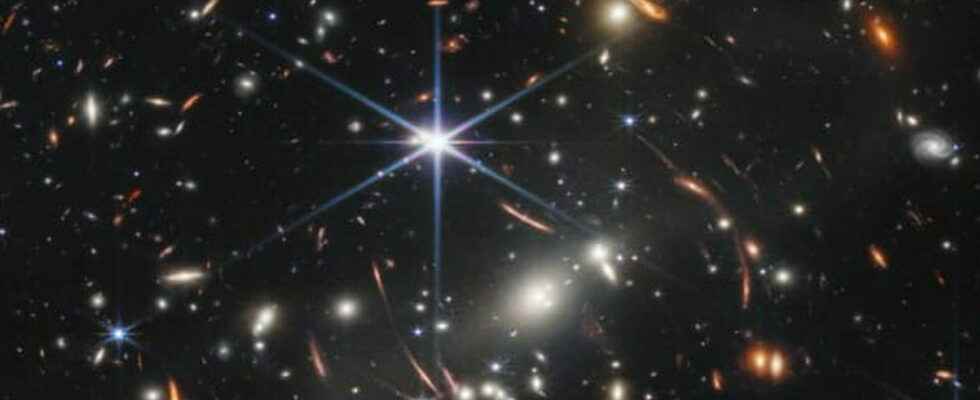UNIVERSE. This Monday, July 11, 2022, President Joe Biden revealed a first snapshot of the depths of the Universe captured by the James Webb Telescope. It is the deepest image of the Universe that we have, and other shots are expected.
[Mis à jour le 12 juillet à 10h13] This Monday, July 11, 2022, at 11 p.m. (French time), US President Joe Biden unveiled a first image transmitted by NASA’s James Webb Space Telescope. This photograph will be followed on July 12 by a new series of photos, presented this time by NASA accompanied by the mission’s partner agencies: the European Space Agency (ESA) and the Canadian Space Agency (CSA). The latter participated in the design of various instruments on board the telescope and the European agency was also responsible for launching the telescope on board an Ariane 5 rocket.
Launched on December 25, 2021, after 30 years of study and design, the James Webb Space Telescope had reached its destination a month later, on January 24. The precision of its takeoff aboard an Ariane 5 rocket was such a success that NASA decided to extend the duration of the mission by 5 years when the telescope had just begun its transit towards its final position. 6 months later, the deployment of the various instruments that make up the telescope went smoothly, allowing NASA to officially launch the mission ofspace exploration of this jewel of technology which is the subject of great expectations on the part of the scientific community.
What does the James Webb Telescope image of the Universe show?
After several months of testing and calibrating the instruments of the James Webb telescope, the long-awaited snapshot was revealed to the world on Monday July 11 at 11 p.m. by the American president. The image is spectacular and shows galaxies formed shortly after the Big Bang, more than 13 billion years ago.
This is the galaxy cluster SMACS 0723, as it was 4.6 billion years ago. “The combined mass of this cluster of galaxies acts as a gravitational lens, magnifying galaxies much more distant behind it whose light took 13 billion years to reach us.” reports Science and Future. The James Webb Telescope will therefore allow researchers to study structures that have never been seen before.
These structures are invisible to us, but not to the most powerful space telescope in the world capable of perceiving wavelengths to which our eyes are insensitive. NASA said it is “the deepest and clearest infrared image of the Universe ever taken”. This photograph marks the beginning of a long research work for astronomers, to discover the origins of the Universe and the formation of galaxies.
Before the publication of the image, NASA had all the same given clues about its nature, specifying that it was one of the targets of the James Webb space telescope. These are the Carina Nebula, known to be the brightest known nebula, the Southern Ring which is about 2,000 light years from Earth or a exoplanet named Wasp-96b, a gas giant planet discovered in 2014. The other two targets of the telescope are the cluster of galaxies “The Stephan Quintet” located in the constellation of Pegasus and the galaxy cluster SMACS 0723 which offers a spectacular view of galaxies extremely distant from Earth by a light-distorting effect.
On July 6, 2022, NASA had already published a first image captured by the James Webb Telescope. It is not a definitive photo, but more of a technical document that allows researchers to test the various instruments with which it is equipped. This shot is actually an assembly of 72 images that gives a taste of the technical capabilities of the telescope. You can see a certain number of stars there, recognizable by their 6 branches which are an optical effect due to the hexagonal mirrors of the telescope. There are also an extraordinary number of galaxies. This technical shot is spectacular and constitutes the most precise image that we have of the depths of the Universe.
Talk about an overachiever!
Gaze at this test image an unexpected & deep view of the universe captured by Webbs Fine Guidance Sensor (FGS) in May. Built-by @csa_asc to point Webb precisely at targets, taking glamor shots isnt even FGSs main job: https://t.co/aQUAFHcNV5 pic.twitter.com/uYoh4t8PX2
—NASA Webb Telescope (@NASAWebb) July 6, 2022
The Universe corresponds to all that exists. It is estimated to be 13.7 billion years old. According to the Big Bang theory, the Universe formed from a hot, dense point that suddenly expanded, creating matter, energy, space and time. The Big Bang theory implies that this expansion would still be at work today.
